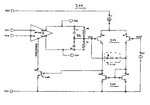jimito13
Advanced Member level 1
Hi,my CMFB loop consists of a two stage miller compenstated opamp with PM>60deg but when i add the circuit on my opamp i get negative phase shift (phase begins from 180deg at the stb analysis of cadence spectre and @ unity gain freq of the loop PM<0).How can i compensate my loop??I must note that i tried to put the 2 capacitors in parallel with the sensing resistors with no result...PM remains negative...
Thanks in advance for any helpful answer.
Thanks in advance for any helpful answer.
